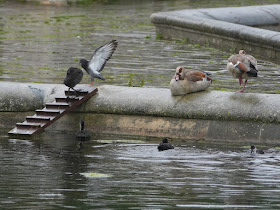A young Blackcap near the bridge was feasting on a heavy infestation of aphids on a burdock stem.
First sight of a young Robin from the nest by the Henry Moore sculpture. It too is old enough to catch its own insects, and had a midge.
A parent watched proudly from a twig.
It was a wet day, and a Jay in a tree by the Serpentine Gallery was looking very soggy ...
... but the familiar Chaffinch nearby was unaffected. It's small enough to shelter under a leaf.
A Swallow skimmed low over the Round Pond, with a Mute Swan out of focus in the background. There were also Swifts and House Martins.
A Pied Wagtail picked up a larva on the gravel strip.
A Grey Wagtail hunted along the edge of the Serpentine.
One of the Reed Warblers under the Italian Garden appeared for a moment before it dashed up the lake. The chicks are still being fed, so it's constantly flying back and forth.
The male at the east end of the lake was singing.
In the absence of Pigeon Eater (temporary, we hope) another Lesser Black-Backed Gull has been lording it over the area around the Dell restaurant for several days.
I've sometimes indistinctly glimpsed a young Grey Heron in a birch a few yards east of the fourth nest, but assumed it was one of the three chicks from that nest wandering around, as they do. But today it appeared ...
... and all three teenagers could also be seen in the fourth nest looking damp and disreputable. So there must be a fifth nest here, well hidden in the leaves.
The eight Coot chicks were milling around in the Italian Garden pool, and one of them climbed a duckboard to attack a Feral Pigeon. The resident Egyptian Geese were resting on the kerb.
You never normally see Coots on the duckboards, or for that matter ducks -- they prefer to jump or fly in and out. But pigeons use them as bathing stations. The Coot chick had attacked the pigeon when it was at the bottom of the board, it retreated, and the chick followed it up.
There was a huge mob of Egyptians by the Dell resturant, with more on the grass up the hill. Probably many of them have flown in to moult as the larger geese do, though Egyptians have a much vaguer schedule for moulting.
The Mallard on the Round Pond is still somehow holding on to her six ducklings.
The Mandarin was on the gravel strip with two ducklings visible. Another two came out from under her wing, but she has lost one since yesterday.
A Common Carder Bee had a thorough feed on a Brook Thistle flower. Each floret contains nectar and needs to be visited.
















Why are they called Carder Bees if they're bumblebees, I wonder? Large, hairy, fluffy and adorable, like its entire genus.
ReplyDeleteGee, that Coot. It looks like something personal.
So the young Blackcap found that aphids are much more palatable than its previous effort.
Tinúviel
There's a Wool Carder Bee too, present in the park but less common. Carding wool is straightening the fibres with a comb so that it can be spun. The bee collects plant fibres to make a nest. So does the Common Carder.
DeleteThat probably is the same young Blackcap as I photographed with the ladybird. It was in almost exactly the same place.